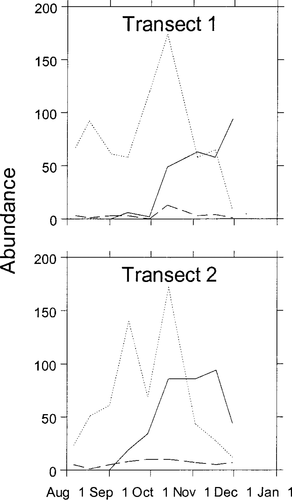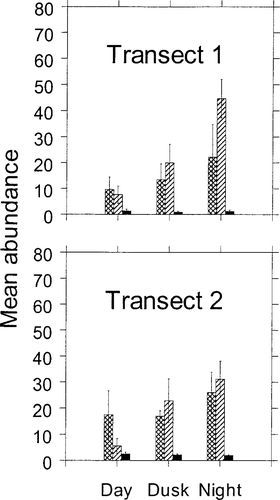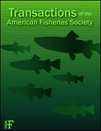Microhabitat Use of Juvenile Atlantic Cod in a Coastal Area of Bonavista Bay, Newfoundland
Abstract
Scuba surveys were used to examine the seasonal abundance and habitat use (substrate, temperature, and depth) of two species of juvenile cod Gadus spp. over the diel cycle in a coastal area of Bonavista Bay, Newfoundland. The abundance of age-0 cod increased throughout the study period (from early August until mid-November), while that of age-1 and age-2 Atlantic cod Gadus morhua peaked in mid-October. The diel abundance of age-1 Atlantic cod increased with the onset of dusk, indicating that these individuals moved from other habitats into the study area at this time. Although all age-classes used areas with kelp significantly more than other areas during the day, the differences between age-classes became apparent at dusk. Age-1 cod showed no significant difference in habitat density at dusk, while age-2 cod had higher concentrations over complex substrates (kelp and boulders); habitat use at dusk by age-0 cod was inconclusive. No significant differences in nocturnal habitat use were found for age-0 and age-1 fish; the results for age-2 fish were inconclusive. Throughout the study period, the 0 and 1 age-classes were found in shallower water at night. Previous studies suggest that diel inshore movements provide metabolic benefits to cod moving through a temperature gradient associated with a distinct thermocline. Although cod occupied colder water during the day in the summer and early fall, the continuation of this diel movement pattern after the disappearance of the thermocline suggests that there are other mechanisms influencing this pattern.
Introduction
The inshore areas of eastern Newfoundland provide fundamental nursery grounds for juvenile Atlantic cod Gadus morhua of the Labrador and eastern Newfoundland cod stock complex (Lear and Wells 1984). Historically, scientists have used offshore catch rates and surveys of adult fish as key components of population estimates. Recently, however, emphasis has been placed on determining the prerecruit abundance in inshore areas and on incorporating this measure into the stock assessment process (Dalley and Anderson 1994). Such a technique has been used successfully for plaice and sole in the North Sea, where population estimates using age-0 and age-1 abundance have been fairly indicative of future recruitment (Rauck and Zijlstra 1978). The accuracy of prerecruit abundance indices depends upon knowledge of juvenile habitat use and activity patterns. In their first year, pelagic juvenile Atlantic cod settle and become demersal in coastal bays and eventually associate with habitats that provide food and protection from predators. As juvenile Atlantic cod mature, they appear to occupy progressively deeper water (Riley and Parnell 1984) and associate with coarser substrates (Keats et al. 1987; Clark and Green 1990), but they do not intermingle with adult conspecifics until approximately age 3–4 (Templeman 1974). This spatial separation during the early life history stages is thought to reduce predation by adult Atlantic cod (Riley and Parnell 1984) and may provide some measure of resource partitioning of available food supplies.
Other than the demonstrated habitat preference of age-0 Atlantic cod (Fraser et al. 1996; Gotceitas et al. 1997), little is known about the diel activity or the partitioning of habitat between various age-classes of juvenile cod (Gregory et al. 1997). The information that does exist is contradictory. In Conception Bay, Newfoundland, juvenile (primarily age-1) cod were found to be abundant in kelp beds during the day (Keats et al. 1987), but no such relationship with algae was observed in Newman Sound, Newfoundland (Keats 1990). In Placentia Bay, Newfoundland, Gregory and Anderson (1997) have shown that in the spring juveniles did not exhibit selection for substrates with macroalgae.
In this study, observations of the habitat use of juvenile Atlantic cod (and, collaterally, of Greenland cod G. ogac) were made using a scuba survey transect method in an inshore nursery area in eastern Newfoundland. The associations of juvenile cod with substrate, depth, and water temperature over diel and seasonal cycles were described.
Study Site
The study site was located in the waters adjacent to Terra Nova National Park in inner Newman Sound, Bonavista Bay, Newfoundland (48°34′N, 54°03′W; Figure 1). The coastline consisted of moderately exposed rocky shore interspersed with sandy coves (pocket beaches). At depths of 0–3 m the dominant substrate was large cobble (10–50 cm in diameter), followed by sand with or without associated smooth cordweed Chorda filum at depths of 5–10 m. The dominant substrate at depths between 10 and 30 m was large cobble with interspersed boulders. The large cobble and boulder area was either barren or covered with the kelp Agarum cribosum. Beyond a depth of approximately 30 m, the substrate was dominated by silt and gravel deposits.

Study site location in inner Newman Sound, Newfoundland
Methods
Two 3.2-mm (diameter) rope transect lines (transect 1 = 250 m and transect 2 = 300 m in length) were strung along the seabed perpendicular to the shore to an approximate depth of 20 m. The two transects were located 250 m apart. Available habitat on the transect lines was characterized by divers every 5 m according to substrate type, depth, and dominant vegetation. Transects were surveyed on consecutive days once every 2 weeks from August 5 to December 1, 1999. Each “day” of observation consisted of daytime (minimum 3 h before sunset), dusk (sunset), and night (minimum 2 h after sunset) survey periods. The surveys were conducted by two divers who swam in a stacked formation above the transect line, with the top diver counting and recording and the bottom diver carrying a 4-m bar mounted with three dive lights. Both divers were further equipped with head-mounted lights. The same divers were used for all data collections, thus eliminating diver-specific variation in counts. Keats (1990) reported that 1-, 2-, 3-, and 4-m-wide transects had no effect on density estimates but that the 4-m transect had the highest precision. In our study, 4 m was the widest practical transect width given the visibility constraints during the dusk and nocturnal surveys. Only cod falling within 2 m of either side of the transect line were counted. The total area surveyed was 1,000 m2 for transect 1 and 1,200 m2 for transect 2.
Age-class was estimated by fish length according to Dalley and Anderson (1997). Both Atlantic and Greenland cod are present in the study area (Linehan et al. 2000). Observers were able to differentiate between the two species with age-1 and older fish, but young-of-the-year could not be identified beyond the genus level. Therefore, in what follows, the 0 age-class includes both Atlantic and Greenland cod while the 1 and 2 age-classes only include Atlantic cod.
Transects were analyzed individually and presented as duplicated experiments for each age-class. Comparisons of diel abundance were conducted with an analysis of variance (ANOVA; Systat 1997). In order to eliminate the variance of the density estimates attributable to seasonal fluctuations, habitat use was reported in terms of relative densities (i.e., the relative density index = the density of cod in a particular substrate/the density of cod in the entire transect). Transects in which no cod were observed were eliminated from the habitat use analysis. Since the data were not consistent with a normal distribution, Monte Carlo methods (Manly 1991) based on 1,000 iterations were used to determine differences in habitat use.
Water temperature data were obtained from thermograph data loggers (Vemco Mini-log TR) spaced 2 m apart along a 20-m moored line held taut at mean low tide by a submerged float. Fish observations were linked to temperature by depth. It was assumed that the vertical temperature profile provided by the thermograph line was representative of the study area.
Results
The abundance of age-1 and age-2 cod increased initially during the study period, peaked in mid-October, and decreased thereafter (Figure 2). The abundance of age-0 fish peaked in mid-November but remained high relative to that of other age-classes.

Seasonal fluctuations of juvenile cod abundance in Buckley Cove, Newfoundland, 1999. Solid lines indicate age-0+ fish, dotted lines age-1+ fish, and dashed lines age-2+ fish
No differences in the abundance of age-0 and age-2 cod were detected with respect to time of day; however, the 1+ age-class showed a significant increase in numbers over both transects (transect 1: F2,24 = 11.64, P < 0.001; transect 2: F2,24 = 5.359, P = 0.012) at night (Figure 3).

Mean abundance of juvenile cod over the diel cycle. Error bars represent the standard error of the mean. Bars with crosshatches indicate age-0+ fish, bars with slanted lines age-1+ fish, and solid bars age-2+ fish
Kelp was used significantly (P < 0.05) more by all age-classes during the day (Figure 4). Differences between age-classes became apparent at dusk, however, when age-1 cod displayed no significant difference in density among habitats while age-2 cod maintained higher levels over complex substrates (kelp and boulders). Habitat use at dusk by age-0 cod was inconclusive as only one of the two transects showed a significant (P < 0.05) difference. No significant differences in nocturnal habitat use were found for age-0 and age-1 fish, while results for age-2 fish were inconclusive.

Mean relative density (density in a particular substrate/density in the entire transect) of age-0, age-1, and age-2 cod in different substrates during the diel cycle. A value of 1 indicates a density that is equal to the transect average, and analogously for values less than and greater than 1. Asterisks represent significant (P < 0.05) differences in relative habitat use. Bars with crosshatches indicate boulders, solid bars indicate gravel, bars with horizontal lines indicate kelp, and bars with slanted lines indicate sand
The depth distribution of age-0 and age-1 cod shifted inshore prior to the dusk observations (Figure 5). Mean depth distributions at night were relatively stable in age-0 (∼7 m) and age-1 (∼9 m) cod but fluctuated over the diurnal period. Dusk distributions were similar to those found at night. There was insufficient data to make a meaningful analysis of the distributions of age-2 cod.

Mean depth and temperature distributions of age-0 cod and age-1 Atlantic cod in Buckley Cove, Newfoundland (August 5−December 1, 1999). Error bars represent the standard error of the mean. Dashed lines indicate day, dotted lines dusk, and solid lines night
In late summer and early autumn, there was a strong horizontal temperature stratification and the 0+ and 1+ age-classes moved inshore to warmer water before the onset of dusk (Figure 5). The temperature differences between the day and night cod distributions were approximately 6°C. Later in the year, as the thermocline disappeared, the temperature differences between the diurnal and nocturnal fish distributions diminished.
Discussion
The seasonal abundance of age-1 and age-2 cod was highest in mid-October and decreased thereafter. This decrease likely reflected migration from autumn habitats in shallow water to winter habitats in deeper water. This seasonal movement is consistent with that found by other studies (Hanson 1996; Gregory and Anderson 1997). Observations of age-0 fish were rare prior to mid-September. However, the abundance of this age-class continued to increase until mid-November. Multiple recruitment pulses of age-0 cod in nearshore eelgrass Zostera marina habitats have been observed in Newman Sound (Gregory et al. 2000). Examination of the length frequency data associated with these pulses reveals a decline in the abundance of the oldest (and largest) pulse coinciding with the rising abundance of age-0 cod over kelp. It is conceivable that larger age-0 cod switched from shallow eelgrass habitats to kelp beds in deeper areas during autumn. The abundance of age-0 cod remained relatively high until the end of the study. Divers frequently observed individuals of this age-class as late as January 24, 2000, suggesting that they persist in these deeper habitats (15–25 m) for the duration of the winter season.
The differences in the abundance of age-0 and age-2 cod were not significant over the diel cycle. Age-1 cod, however, were more abundant nocturnally. An increase in dusk and nighttime abundance has also been reported for other inshore areas in Newfoundland (Keats 1990; Methven and Badjik 1994; Anderson and Dalley 1995) and on the west coast of Sweden (Pihl 1982). Juvenile cod may remain concealed in refuges such as eelgrass, kelp, and crevices during the day. However, after extensive searching through macroalgae and crevices, Keats (1990) was unable to confirm their presence in those habitats. Instead, he proposed that they move to deeper water or upward in the water column diurnally. Although the observations in this study were restricted to within a few meters of the bottom, few cod were observed in areas more than ∼1 m above the substrate.
Diel patterns in habitat use were observed in all age-classes. Laboratory studies have shown that age-0 cod exhibit distinct substrate preferences based on particle size or vegetation (Gotceitas and Brown 1993; Gotceitas et al. 1995; Fraser et al. 1996). Diurnally, in the inshore waters of inner Newman Sound, age-0 cod were often found schooling in kelp (at an average density of 4 times the transect density). At dusk, the highest densities of fish were still found in complex substrates (boulders and kelp) but the distributions shifted to more open areas (gravel and sand) at night. Gotceitas et al. (1995) showed that the presence of kelp as well as cobble increased the survival of age-0 cod in the presence of an actively foraging predator. It is plausible that these fish delay their migration to less complex habitats until night when visual predators are less efficient foragers. Observations in coral reefs reveal that nocturnal fish do not leave the cover of the reef until after dark, a behavior that is thought to reduce predation risk (Hobson 1972). A predation study in Newman Sound (Linehan et al. 2000) has demonstrated that the predator encounter rates of tethered age-0 cod diminish at night. Habitat use by age-1 and age-2 cod was similar to that of younger conspecifics in that higher densities of fish were associated with kelp during the day. At dusk and during the night, however, age-1 cod were less associated with kelp than were age-2 cod, which maintained higher densities over complex substrates at dusk. These results are consistent with those of Keats et al. (1987) and Gotceitas et al. (1997), who demonstrated that age-1 and age-2 cod prefer fleshy macroalgae during the day. Other studies (Keats 1990; Gregory and Anderson 1997) reported that age-1 and age-2 cod were not associated with algae beds diurnally. These disparities may reflect behavioral changes associated with the season.
Diver avoidance by cod could have influenced the observed trends in diel abundance and habitat density. Although the cod observed during this study could be approached close enough to count, they would swim away as divers advanced. Although habitat-specific behavior toward divers was not obvious, there were few daytime observations over open areas (gravel and sand substrates) on which to base conclusions. Therefore, it is possible that fish inhabited these areas but dispersed before they could be detected. In a similar study, repeated counts of the same transect showed no evidence of diver attraction or repulsion by juvenile Atlantic cod (Keats 1990).
From early August to December, juvenile cod (age-classes 0 and 1) spent the days in deeper, cooler water and migrated into shallower, warmer water at night. As the water column became isothermal in autumn, individuals continued to migrate nocturnally into shallower water. Clark and Green (1990) observed that age-3 cod exhibited this migratory pattern during the summer (June–September) but that it disappeared in the fall (mid-September–December) when the water column became isothermal. A subsequent laboratory study (Clark and Green 1991) demonstrated that this diel migration would provide physiological benefits if fish were moving through a thermocline, increasing energetic efficiency by reducing metabolic costs. Our data indicate that age-0 and age-1 cod continued to migrate despite the disappearance of the thermocline, suggesting that this behavior may also be beneficial for other reasons (e.g., increased feeding opportunities or reduced predation risk).
This study indicates that kelp is an important diurnal habitat for juvenile cod (ages 0–2) in inner Newman Sound. However, assessments need to be done over a broader geographical range before these findings can be factored into abundance assessments of prerecruits. The continuation of the diel movements exhibited by cod despite the absence of a thermocline is also noteworthy. The potential physiological benefits obtained from behavioral thermoregulation would have declined as the water column became isothermal, suggesting that there are other mechanisms involved.
Acknowledgments
We are grateful to Terra Nova National Park for in-kind support, particularly that from Peter Deering and Renee Wissink. We thank Lloyd Cole, Neil Ollerhead, Curtis Pennell (Department of Fisheries and Oceans), Danny Croke, John Denty, and Walter Drew (Terra Nova National Park) for field and technical assistance. Danny Ings and David Schneider were of great service in guiding us through the Monte Carlo analysis. Finally, we are indebted to the many study volunteers, Kerry Arnold, Andrea Churchill, Doug Churchill, Rod Cox, Brian Feltham, John Gosse, Keith Hounsell, Randy Mercer, Melvin Moulton, Delana Perrier, Bruno Piccinin, Dean Rowsell, Gilbert Stone, Steve Way, and the students of Katimavik Canada, without whom this study could not have been accomplished. Comments on the manuscript by Jeanette O'Hara-Hines, Joe Brown, Bob Gregory, and anonymous reviewers contributed significantly to this work. Funding for this research was provided by the Environmental Sciences Strategic Research Fund of the Department of Fisheries and Oceans and by a Natural Sciences and Engineering Research Council of Canada grant to R.S.M.




